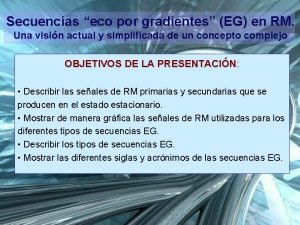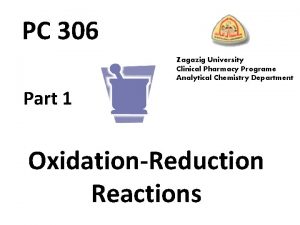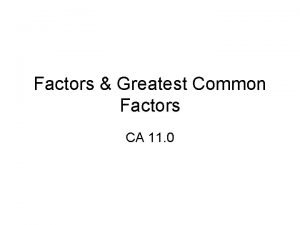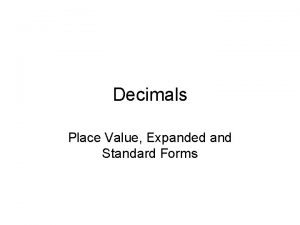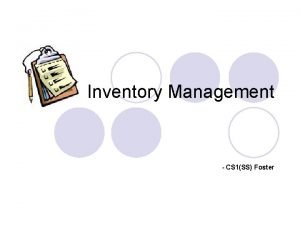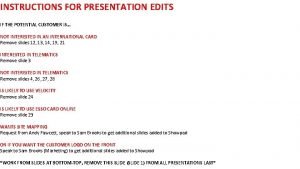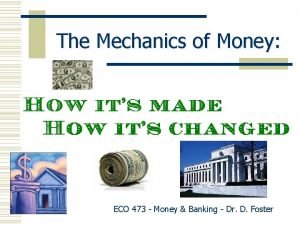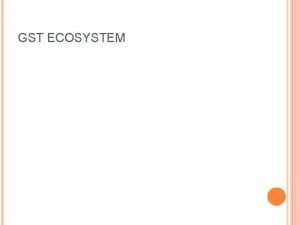Eco 306 W 1 A Overview of Course























































- Slides: 55

Eco 306 W 1 A Overview of Course Current Macro Position and Issues, John Berdell jberdell@depaul. edu

ECO 306 Home Page http: /www. depaul. edu/~jberdell Select Eco 306 ID: macro PW: theory

Today’s Outline 1 Course requirements 2 A LR Growth: why it matters 2 B LR Growth: policy issues 3 A SR Fluctuations 3 B SR Forecasting 4 SR Policy Issues 5 Syllabus Overview

1 Course Requirements Myeconlab homework, constitutes most of exams 2 Data exercises from web page due w 5 and w 9 Exams 20% multiple choice 50% short answers from the problem sets 30% essays linked to outside readings Paper: US Macro Outlook and Research Review Demonstrate familiarity with basic macro stats. Evaluate the economy’s current position in the business cycle and competing forecasts.

1 Homework Myeconlab Homework: First half of course First batch due Mon 9/27/2010 2 am 1 Ch 1 2 Ch 2 3 Ch 2 Numerical 5 4 Ch 3 5 Ch 3 Numerical 9 6 Ch 4 7 Ch 4 Numerical 7 8 Ch 5 9 Ch 5 Numerical 3 10 Ch 6 11 Ch 6 Numerical 2 12 Ch 6 Numerical 5

Midterm • Multiple choice from chapter MC/TF questions. • Several problems from the 6 numerical problems in the homework. • One essay question.

Homework second half • • • • 13 Ch 7 14 Ch 8 15 Ch 9 16 Ch 9, Numerical 4 17 Ch 10 18 Ch 10 Numerical 1 19 Ch 10 Numerical 2 20 Ch 11 21 Ch 11 Numerical 1 22 Ch 11 Numerical 3 23 Ch 12 24 Ch 12 Numerical 4 25 Ch 13 26 Ch 14 27 Ch 15

Final • Final is cumulative • Multiple choice from chapter MC/TF questions • Problems from the 12 numerical problems • One essay question

Homework and Exam Problems • See helpful hints documents: NI. doc, Solow. doc, ISLM. doc, etc. These have solved examples in them of all the numerical problems arranged by topic. • Solved answers to the book’s problems have been posted on the class web page. • Myeconlab and exam problems are very similar but with altered numerical values.

1 Our Text Able/Bernanke/Croushore Macroeconomics Seventh or Sixth Ed. Purchase instructions on D 2 L

Myeconlab • Go to www. myeconlab. com • To join your instructor's course, please complete the following two steps: 1. REGISTER for My. Econ. Lab, and, 2. ENROLL in your instructor's course To Register for My. Econ. Lab To register, you will need a student access code and a course ID. If you don't have an access kit, you can purchase access online at http: //www. myeconlab. com. You will have the choice to purchase access with or without a full etext. Once enrolled in your professor's course, you will also have the option to purchase a discounted version of your text. See details on D 2 L, you will need the course ID

Intermediate Macro is: Study of Growth Is: Growth Accounting What are the sources of growth Solow Growth Model What is the equilibrium position of the eco? Comparative Growth How has growth varied over countries and in response to different policies? Advanced Macro would give lots of attention To Econometric methods and issues.

Intermediate Macro is: The study of economic fluctuations The extended use of the ISLM model that you began to see in principles. How do changes in spending behavior and gov. policies affect the quarter to quarter rate of growth? How do financial markets fit in? Advanced macro is based on explicit intertemporal maximization.

2 Why do we care about growth? 2 A Growth-Poverty links

Location of Poverty From WDR

Change in Poverty

Growth and Poverty





Current Macro Position • • Labor Market Demand Sector Balances Fiscal Policy Conflict Monetary Accommodation and Currency Wars • Forecasts

Some Sources • JP Morgan Chase, Markets and the Economy, senior chief economist, James Glassman • FT, Sir. Martin Wolf, Chief Economist • Moody’s-Dismal Scientist, Mark Zandi, Founder and Chief Economist

Labor Market 9. 1% Unemployment No job growth August 2011 Commodity price spikes unlikely to cause inflation in the absence of wage inflation. You will estimate Okun’s Law (growth of output vs change in Ue rate) in this class.

Labor • Very high long term unemployment. • Ue benfits are by state with Federal assistance. State benefit funds in crisis. • 99 week max only with 2 extensions.

We forgot about cycles…. • “Each state determines the appropriate funding level for their own trust fund, and for many years, the general policy trend has been to keep payroll taxes very low. According to the Government Accountability Office, unemployment trust funds are in historically poor financial condition. Total state reserves in 2000 came to about $54 billion. That number had dropped to $38 billion by the end of 2007 when the recession hit. [1] This meant that many states entered the economic downturn with underfunded unemployment trust fund balances and by the end of 2009, balances (excluding loans) had fallen to -$15. 4 billion, the lowest level in the program’s history” http: //www. ncsl. org/? tabid=22475

Labor • Need growth > 3 or 3. 5% • Need monthly job creation > 100 -125 K

Labor Months to get back to pre-recession employment levels (while absorbing the 125 K entrants each month) Brookings Institution, Nov 5 2010. • Unrealistic. http: //www. brookings. edu/opinions/2010/1105_jobs_greenstone_looney. aspx? rssid=looneya

Demand-Sector Balances • “Balance sheet” recessions are tough. • Businesses have excess cash and are hording it.

Demand-Sector Balances • “Balance sheet” recessions are tough. • House holds want to pay down debt or save.

Demand-Sector Balances • “Balance sheet” recessions are tough. • Net exports can only do so much.

Demand-Sector Balances • Households saved too little. Housing ATM is now broken. Good BEA graph site: http: //www. bea. gov/

Housing • Consumers respond to their wealth. Middle income households are reliant on housing wealth rather than equities.

Housing • Housing ATM has been broken for some time now.

Balance Sheet Recessions • We will look at Japan and the GD as examples of balance sheet recessions. • 1930’s Irving Fisher introduces “debt deflation” • 1990 Japan starts 2 lost decades

Japan: GDP stagnati on The Economist/ Free exchange blog 23 Aug 2010 http: //www. economist. com/blogs/freeexchange/2010/08/growth_3

Krugman (Keynesian view) • “But the truth is that policy makers aren’t doing too much; they’re doing too little. Recent data don’t suggest that America is heading for a Greece-style collapse of investor confidence. Instead, they suggest that we may be heading for a Japan-style lost decade, trapped in a prolonged era of high unemployment and slow growth. “ Lost Decade Looming? By PAUL KRUGMAN NYT Published: May 20, 2010 http: //www. nytimes. com/2010/05/21/opinion/21 krugman. html

Japan Austrian View • In non-population adjusted figures, Japan's real GDP grew by 26% in total these years [1990 -2007], the lowest in the OECD. In comparison the figures are 63% for the U. S and 44% for the EU. 15. • But during this period the U. S saw its potential labor force (the number of people between 15 -65) increase by 23% and the EU. 15 by 11%, while Japan had a decrease of 4%. • Between 1990 -2007, GDP per working age adult increased by 31. 8% in the United States, by 29. 6% in EU. 15 and by 31. 0% in Japan. The figures are nearly identical! Japan has simply not been growing slower than other advanced countries once we adjust for demographic change. http: //motherjones. com/kevin-drum/2010/05/japans-lost-decade-not-really-lost http: //super-economy. blogspot. com/2010/05/paul-krugman-wrote-in-nyt-that-we-are. htm

0, 0 1971 1972 1973 1974 1975 1976 1977 1978 1979 1980 1981 1982 1983 1984 1985 1986 1987 1988 1989 1990 1991 1992 1993 1994 1995 1996 1997 1998 1999 2000 2001 平成 14年 2002 平成 15年 2003 平成 16年 2004 平成 17年 2005 平成 18年 2006 平成 19年 2007 平成 20年 2008 平成 21年 2009 平成 22年 2010 Japan %U rate 15 to 24 yr olds 12, 0 10, 0 8, 0 6, 0 Series 1 4, 0 2, 0 http: //www. stat. go. jp/english/data/roudou/lngindex. htm

Japan’s Stocks and Bonds • Japan’s ‘lost decade’ wins fresh attention • By James Mackintosh • Published: August 31 2010 19: 33 | Last updated: August 31 2010 19: 33 • “Central bankers have yet to work out how Japan in the 2000 s avoided the dark side of deflation, the Great Depression-style downward spiral of rising debt and falling output. But for investors Japan carries just one lesson: deflation means falling shares and rising bonds, even if the economy survives. ” • http: //www. ft. com/cms/s/0/f 1001 b 8 c-b 52 a-11 df-9 af 800144 feabdc 0. html

• This is JP Morgan Chase again • 2011 Q 2/2010 Q 4 = 0. 7 (Far below 3 or 3. 5)

http: //www. economy. com. ezproxy 2. lib. depaul. edu/dismal/pro/release. asp? r=usa_gdp see page for C I G X-M, I actually strong for Q 2 2010

Growth or Spending? • Tremendous disagreement over the role of expectations in the near term growth process. What will revive confidence? More government spending or austerity and supply-side measures?

Growth • If long term growth were known to be faster then expectations would carry us out of our short term growth trap. With fast long term growth any downturn is (by definition) followed by a strong ‘pop’ in growth. 5% or more. Consumers and Businesses, confidently expecting this pop will spend in anticipation. Problem solved.

Spending View • Business surveys report absence of demand rather than supply factors as reason for low hire rates. • NFBI Small Business Economic Trends (Survey)

Demand-Sector Balances • When government spending falls (even when that spending is high) it is a negative contribution. Mark Zandi http: //www. economy. com/mark-zandi/

• Zandi/ • Dismal multipliers

Monetary Policy and Currency Wars • Low interest rates lower currency values of floating currencies.

China and the USA • China continues to buy lots of US gov debt and it is one of the few countries with an inflation problem. • It is an excellent example of a “successful” fiscal stimulus 2008 -2010.

China http: //www. economy. com. ezproxy 2. lib. depaul. edu/dismal/map/default. asp

China’s Credit Expansion • “Chinese banks expanded credit at a record pace in 2009 and 2010, making more than 17. 5 trillion yuan ($2. 7 trillion) of new loans as the government moved to offset a collapse in exports during the global recession. About a third of local government financing vehicles, used to get around laws prohibiting direct borrowing, don’t have cash flow to service their debt, according to China’s banking regulator. ” http: //bloom. bg/pnrf. H 1

• Does not include bank lending

Forecasts for 2011 • JP Morgan Chase

Zandi/Dismal • Real GDP is now expected to expand at an annualized rate near 2% during the second half of 2011, and just over 3% next year. A month ago we projected GDP growth at 3. 5% during the second half of this year and through 2012. A reduced rate of consumer spending growth accounts for most of the downward revision. (11 Aug 2011) • http: //www. economy. com/dismal/article_free. asp? cid=224006&src=mark-zandi

Click on View, Headers and Footer to change text footer. • But you have your own view……
 Eco gradiente
Eco gradiente Som 306 csun
Som 306 csun Meteorologia cesar
Meteorologia cesar Operations management lecture notes doc
Operations management lecture notes doc Buad 306
Buad 306 Pc 306
Pc 306 Allied core value rbp
Allied core value rbp 306
306 Troop 306 avon
Troop 306 avon 306 bones
306 bones Paulo sentelhas e angelocci geadas aula lce 306
Paulo sentelhas e angelocci geadas aula lce 306 Factors 75
Factors 75 306 in expanded form
306 in expanded form Ed 306
Ed 306 Navsup form 1282
Navsup form 1282 Meteorologia
Meteorologia 306 subject code
306 subject code Product structure tree example
Product structure tree example 306
306 Cuales son las tres virtudes teologales
Cuales son las tres virtudes teologales Soldier course vs sailor course
Soldier course vs sailor course Course title and course number
Course title and course number Chaine parallèle muscle
Chaine parallèle muscle Esr eco systeme
Esr eco systeme Eco 4001
Eco 4001 Eco ptz banque populaire
Eco ptz banque populaire Sanyo co2 eco 4 5kw
Sanyo co2 eco 4 5kw Esso card online velocity
Esso card online velocity Eco kit
Eco kit Rametsi eco game farm
Rametsi eco game farm Eco mechanics
Eco mechanics Karnataka tourism society
Karnataka tourism society Eco cyc
Eco cyc Que es el pacto ficcional
Que es el pacto ficcional Global eco the saem
Global eco the saem Emulpharma eco 10
Emulpharma eco 10 Tnrd landfill
Tnrd landfill Por donde se propaga el sonido
Por donde se propaga el sonido Sobreiro
Sobreiro Eco 92
Eco 92 Prof eco
Prof eco Fiche éco-conduite
Fiche éco-conduite Just eco
Just eco Eco village alberta
Eco village alberta Pinless dialing
Pinless dialing Eco schools 7 steps
Eco schools 7 steps Eco-system
Eco-system Eco 92
Eco 92 Eco cyc
Eco cyc Poesa
Poesa Carte de restriction linéaire
Carte de restriction linéaire Define gst eco system
Define gst eco system Metabond eco
Metabond eco Eco start up
Eco start up Tanka images
Tanka images Eco atms near me
Eco atms near me
